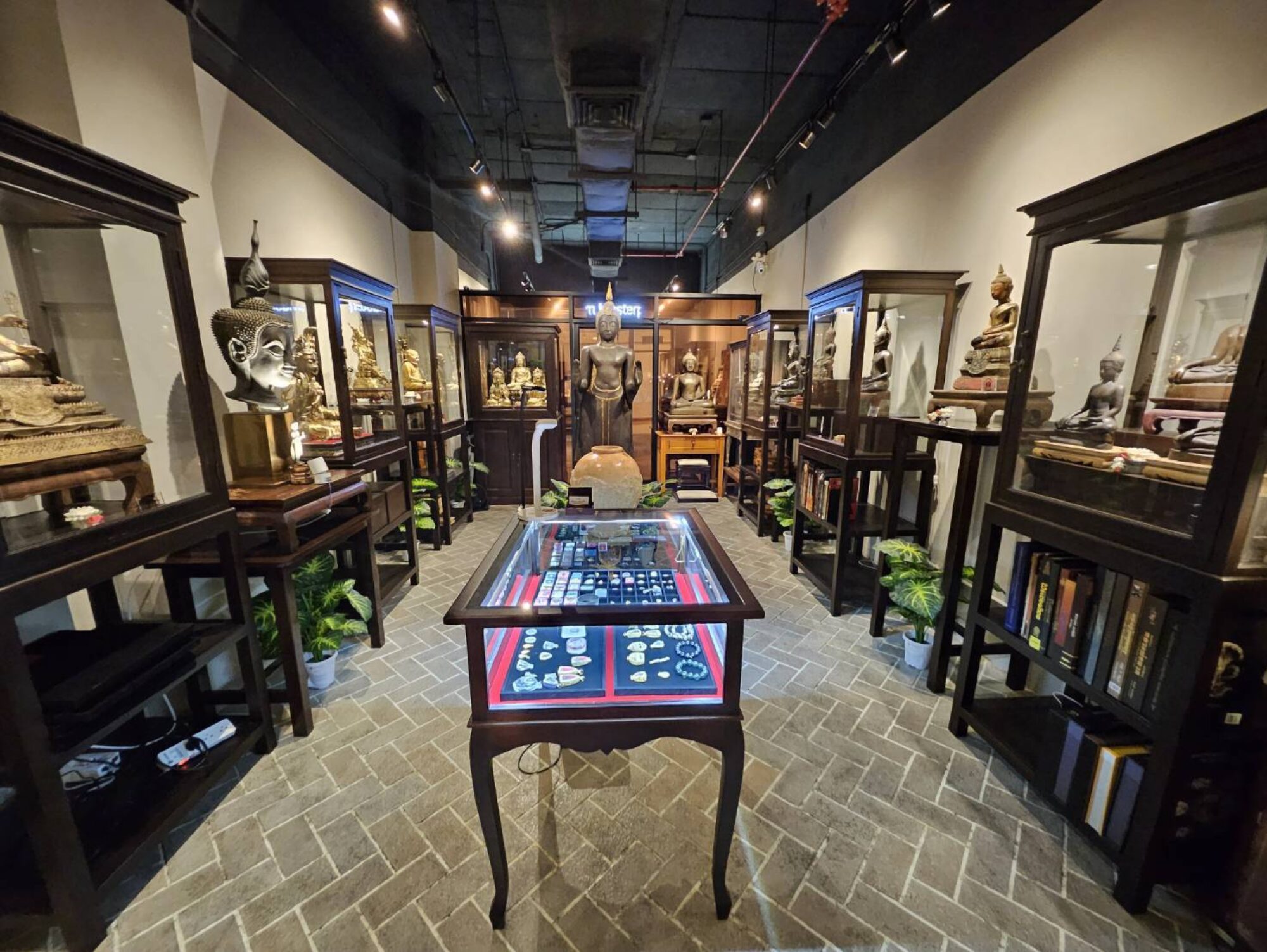
รายละเอียดพระบูชา:
พระพุทธรูปองค์นี้เป็นศิลปะ เชียงแสน สิงห์ 1 หรือที่เรียกว่า สิงห์แรก ซึ่งเป็นศิลปะยุคต้นของเมืองเชียงแสน (อาณาจักรล้านนา) สร้างขึ้นในช่วง พุทธศตวรรษที่ 18–19 (ประมาณ ค.ศ. 1350–1450)
ลักษณะเด่นทางศิลปะ:
- พระพักตร์:
- พระพักตร์กลม อิ่มเอิบ และแสดงความเมตตาอย่างเด่นชัด
- พระนลาฏ (หน้าผาก) กว้าง โค้งนูนเล็กน้อย ดวงตายาวรีคล้ายผลขนุนหลุบต่ำ
- พระโอษฐ์เล็กและยิ้มพองาม ดูละม้ายคล้ายศิลปะ กรีก-โรมัน ในแง่ของความสมมาตรและความงดงาม
- พระเกตุมาลา (ยอดพระเศียร):
- ยอดพระเกตุมาลาทรงดอกบัวตูม อันเป็นลักษณะเฉพาะของพระเชียงแสน
- พระอุระ (อก):
- กว้าง อวบอิ่ม สื่อถึงความสมบูรณ์และมั่นคง
- พระอิริยาบถ:
- ประทับขัดสมาธิราบใน ปางมารวิชัย หมายถึงชัยชนะเหนือมารและอุปสรรคทั้งปวง
- จีวร:
- จีวรแนบเนื้อ เปิดไหล่ขวาแบบเรียบง่าย แต่ดูสง่างาม
- ฐานเขียง:
- ฐานรององค์พระเป็นแบบเรียบ (ฐานเขียง) ซึ่งนิยมใช้ในศิลปะเชียงแสนยุคแรก
ตำนานและความเชื่อในการสร้าง:
พระพุทธรูปเชียงแสน สิงห์ 1 มักถูกสร้างขึ้นเพื่อใช้เป็นเครื่องยึดเหนี่ยวจิตใจในสมัยอาณาจักรล้านนา เชื่อว่าเป็นตัวแทนของ พระพุทธเจ้า ที่ช่วยนำทางผู้คนให้พ้นทุกข์
- ตำนานศักดิ์สิทธิ์:
- สร้างขึ้นโดยช่างฝีมือในสมัยล้านนา เพื่อเฉลิมฉลองพุทธศาสนาและเสริมสิริมงคลแก่บ้านเมือง
- ศิลปะสะท้อนความศรัทธา:
- เชื่อว่าพระพุทธรูปสิงห์ 1 มีพลังปกป้องคุ้มครองจากภยันตราย และช่วยเสริมดวงชะตาให้กับผู้บูชา
ความศักดิ์สิทธิ์และความเชื่อ:
- ป้องกันภัยพิบัติและอุปสรรค:
- ปางมารวิชัยเป็นสัญลักษณ์แห่งชัยชนะเหนืออุปสรรคและความทุกข์
- เสริมความมั่นคงและเจริญรุ่งเรือง:
- นิยมบูชาในบ้านเรือนหรือสถานที่ทำงาน เพื่อเสริมโชคลาภและความก้าวหน้า
- เสริมบารมีและอำนาจ:
- เชื่อว่าผู้ครอบครองจะได้รับความเคารพและมีบารมีต่อผู้คนรอบข้าง
- เครื่องเตือนใจในการดำเนินชีวิต:
- ส่งเสริมให้ผู้บูชามีสติปัญญาและสมาธิในการดำเนินชีวิตอย่างมีธรรมะ
บทสรุป:
พระพุทธรูปองค์นี้เป็นพระพุทธศิลป์ใน สมัยเชียงแสน สิงห์ 1 (พุทธศตวรรษที่ 18–19) มีเอกลักษณ์ด้านความงดงามแบบ กรีก-โรมัน ในพระพักตร์ที่อ่อนโยน สื่อถึงความสงบและเมตตา เหมาะสำหรับการบูชาเพื่อเสริมสิริมงคล ความมั่นคง ปกป้องภัย และเพิ่มพูนบารมี เหมาะอย่างยิ่งสำหรับผู้ที่ต้องการนำไปประดับบ้านหรือสถานที่ศักดิ์สิทธิ์เพื่อความเจริญรุ่งเรือง
Buddha statue, Chiang Saen, Singh 1, lap width 21 inches
Buddha statue details:
This Buddha statue is in the art of Chiang Saen, Singh 1 or known as Singh Rak, which is the early art of Chiang Saen (Lanna Kingdom), built during the 18th–19th Buddhist century (approximately 1350–1450 AD).
Artistic characteristics:
Face:
The face is round, plump and clearly shows compassion.
The forehead is wide, slightly curved, the eyes are long and oval like jackfruits, lowered.
The mouth is small and smiles beautifully, similar to Greco-Roman art in terms of symmetry and beauty.
Ketumala (top of the head):
The top of the Ketumala is shaped like a lotus bud. Characteristics of Chiang Saen Buddha
Chest:
Wide, plump, conveying completeness and stability
Posture:
Sitting cross-legged in the Mara-Vijaya posture, meaning victory over Mara and all obstacles
Robe:
A robe that is close to the body, revealing the right shoulder in a simple but elegant style
Pedestal:
The base of the Buddha image is a plain type (pedestal), which was popular in early Chiang Saen art.
Legend and belief in creation:
Chiang Saen Buddha image, Singh 1, was often created to be a spiritual support during the Lanna Kingdom. It is believed to represent the Lord Buddha who helps people escape suffering.
Sacred legend:
Created by craftsmen during the Lanna period to celebrate Buddhism and bring good fortune to the country.
Art reflects faith:
It is believed that the Singh 1 Buddha image has the power to protect from danger and helps enhance the destiny of the worshipper.
Sacredness and belief:
Protects against disasters and obstacles:
The Mara-Vijaya posture is a symbol of victory over obstacles and suffering.
Enhances stability and prosperity:
Popular for worship in homes or workplaces To enhance fortune and progress
Enhance charisma and power:
It is believed that the owner will be respected and have charisma from people around him.
A reminder for living life:
It encourages the worshipper to have wisdom and concentration in living a life with Dharma.
Conclusion:
This Buddha statue is a Buddhist art in the Chiang Saen period, Singh 1 (18th-19th Buddhist century). It has a unique beauty in the Greco-Roman style. The gentle face conveys peace and kindness. It is suitable for worship to enhance auspiciousness, stability, protection from danger, and increase charisma. It is especially suitable for those who want to decorate their homes or sacred places for prosperity.
佛像清盛辛格 1,膝宽 21 英寸
佛像详情:
这尊佛像是Chiang Saen Singh 1艺术,也称为Singha Raek,是清盛早期的一种艺术形式。 (兰纳王国)建于18 世纪至 19 世纪(约公元 1350 年至 1450 年)
艺术特色:
他的脸:
他的脸圆圆的,饱满,显出明显的慈祥。
额头(额头)宽阔,略呈弧形。长而椭圆形的眼睛像菠萝蜜,位置低。
他的嘴很小,笑容很美。在对称性和美感方面与希腊罗马艺术相似。
Phra Ketumala(头顶):
Phra Ketumala 的顶部形状像莲花花蕾。这是Phra Chiang Saen的独特之处
帕胸(胸部):
宽而丰满,代表完整、稳定。
姿势:
以马拉维猜式盘腿而坐,意味着战胜魔鬼和一切障碍。
黄袍:
袍子贴身,露出右肩,简约而不失优雅。
切菜板底座:
佛像的底座是光滑型(切板底座),这在早期清盛艺术中常用。
传说和创造信仰:
清盛辛格 1 号佛像在兰纳王国时期经常被建造作为锚。人们相信它代表着帮助引导人们摆脱痛苦的佛陀。
神圣传说:
由兰纳时期的工匠建造。弘扬佛教,为国家带来吉祥。
艺术反映信仰:
人们相信,Singha 1 佛像具有驱除危险的力量。并帮助增强崇拜者的财富
圣洁与信仰:
预防灾害和障碍:
马拉维猜姿势是战胜障碍和痛苦的象征。
增强稳定和繁荣:
受欢迎的家庭或工作场所崇拜增强运气和进步
增加威望和权力:
相信主人会受到周围人的尊重和威望。
生活提醒:
鼓励信徒在佛法生活中拥有智慧和专注。
结论:
这尊佛像是清盛辛一世时期(18-19世纪)的佛像,具有希腊罗马风格的独特美感,面容温柔。它传达和平与仁慈。适合供奉,可增强吉祥、稳定、避险、增加威望。非常适合那些想要装饰自己的房屋或圣地以实现繁荣的人。
